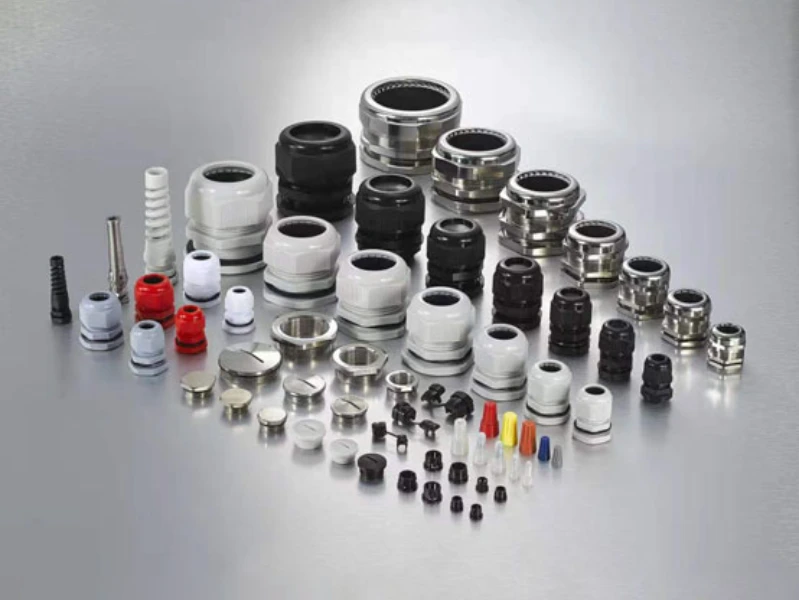Οι στυπιοθλίπτες καλωδίων διαδραματίζουν κρίσιμο ρόλο στην εξασφάλιση και προστασία των ηλεκτρικών συνδέσεων, με τις επιλογές από νάιλον και επινικελωμένο ορείχαλκο να προσφέρουν ξεχωριστά πλεονεκτήματα για διαφορετικές εφαρμογές. Όπως αναφέρουν πηγές του κλάδου, οι καλωδιακοί στυπιοθλίπτες από επινικελωμένο ορείχαλκο προτιμώνται για την ανώτερη αντοχή τους, την αντίσταση στη διάβρωση και την απόδοσή τους σε σκληρά περιβάλλοντα σε σύγκριση με τους αντίστοιχους νάιλον στυπιοθλίπτες.

1. Υλικό
Οι ορειχάλκινοι καλωδιακοί στυπιοθλίπτες με επικάλυψη νικελίου αποτελούνται από κράμα βάσης ορείχαλκου, συνήθως χαλκού και ψευδαργύρου, ενισχυμένο με επικάλυψη νικελίου για ανώτερη προστασία. Αυτός ο συνδυασμός προσφέρει εξαιρετικές μηχανικές ιδιότητες και αντοχή στη διάβρωση, καθιστώντας τον ιδανικό για σκληρά περιβάλλοντα. Ο ορειχάλκινος πυρήνας παρέχει αντοχή και αγωγιμότητα, ενώ η επικάλυψη νικελίου ενισχύει σημαντικά την αντοχή στην υγρασία, τα χημικά και το αλμυρό νερό.
- Ενισχυμένη ανθεκτικότητα έναντι καταπονήσεων, δονήσεων και κρούσεων
- Βελτιωμένη αντοχή σε ασθενή οξέα και διάφορες χημικές ουσίες
- Ανώτερη απόδοση σε περιβάλλοντα αλμυρού νερού
- Διατήρηση της ηλεκτρικής αγωγιμότητας με πρόσθετα προστατευτικά οφέλη
- Παρατεταμένη διάρκεια ζωής λόγω αυξημένης αντοχής στη σκουριά και την υποβάθμιση
Αυτές οι ιδιότητες καθιστούν τους επινικελωμένους ορειχάλκινους στυπιοθλίπτες καλωδίων ιδιαίτερα κατάλληλους για εφαρμογές σε πετροχημικά, θαλάσσια και βιομηχανικά περιβάλλοντα, όπου οι περιβαλλοντικοί παράγοντες θέτουν σημαντικές προκλήσεις για την ακεραιότητα του εξοπλισμού.
2. Δύναμη
Οι επινικελωμένοι ορειχάλκινοι στυπιοθλίπτες καλωδίων είναι πολύ ισχυρότεροι από τους νάιλον εναλλακτικούς, καθιστώντας τους ιδανικούς για εφαρμογές που απαιτούν υψηλή μηχανική αντοχή. Με πυρήνα από κράμα ορείχαλκου που παρέχει εξαιρετική αντοχή σε εφελκυσμό - συγκρίσιμη με ή ακόμη και μεγαλύτερη από χάλυβα χαμηλού άνθρακα - αυτοί οι στυπιοθλίπτες αντέχουν σε σημαντικές καταπονήσεις, όπως τράβηγμα, κάμψη και κραδασμούς, χωρίς να διακυβεύεται η δομική τους ακεραιότητα ή η απόδοση στεγανοποίησης. Για εφαρμογές που απαιτούν ακόμη μεγαλύτερη αντοχή, το μήκος του σπειρώματος των ορειχάλκινων στυπιοθλιπτών μπορεί να επεκταθεί για να βελτιωθεί η φέρουσα ικανότητα.
3. Εύρος ανοχής θερμοκρασίας
Οι ορειχάλκινοι στυπιοθλίπτες καλωδίων με επικάλυψη νικελίου προσφέρουν ανώτερες επιδόσεις στη θερμοκρασία σε σύγκριση με τις εναλλακτικές λύσεις από νάιλον, καθιστώντας τους ιδανικούς για ακραία περιβάλλοντα. Αυτοί οι στυπιοθλίπτες μπορούν συνήθως να λειτουργούν σε θερμοκρασίες που κυμαίνονται από -60°C έως 200°C (-76°F έως 392°F), υπερτερώντας σημαντικά έναντι των νάιλον στυπιοθλιπτών που λειτουργούν γενικά μεταξύ -40°C έως 100°C (-40°F έως 212°F). Αυτό το εκτεταμένο εύρος θερμοκρασιών επιτρέπει στους επινικελωμένους ορειχάλκινους στυπιοθλίπτες να διατηρούν την ακεραιότητά τους και τις ιδιότητες στεγανοποίησής τους τόσο σε κρυογονικές εφαρμογές όσο και σε βιομηχανικές συνθήκες υψηλής θερμοκρασίας.
4. Αντοχή στη διάβρωση
Οι ορειχάλκινοι στυπιοθλίπτες καλωδίων με επικάλυψη νικελίου προσφέρουν ανώτερη αντοχή στη διάβρωση σε σύγκριση με τους αντίστοιχους νάιλον στυπιοθλίπτες, καθιστώντας τους ιδανικούς για σκληρά περιβάλλοντα. Η επικάλυψη νικελίου ενισχύει σημαντικά τη φυσική αντίσταση του πυρήνα ορείχαλκου στη διάβρωση, παρέχοντας προστασία από την υγρασία, τα ασθενή οξέα, τη βενζίνη, το αλκοόλ και το αλμυρό νερό. Αυτό τους καθιστά ιδιαίτερα κατάλληλους για θαλάσσιες εφαρμογές και βιομηχανικές εγκαταστάσεις όπου η έκθεση σε διαβρωτικά στοιχεία είναι συχνή.
5. Βάρος
Οι καλωδιακοί στυπιοθλίπτες από ορείχαλκο με επικάλυψη νικελίου είναι σημαντικά βαρύτεροι από τους αντίστοιχους από νάιλον, γεγονός που μπορεί να αποτελέσει πλεονέκτημα αλλά και περιορισμό ανάλογα με την εφαρμογή. Το βάρος των ορειχάλκινων στυπιοθλιπτών συμβάλλει στη στιβαρότητα και την ανθεκτικότητά τους, καθιστώντας τους ιδανικούς για βιομηχανικές χρήσεις βαρέως τύπου. Για παράδειγμα, ένας επινικελωμένος ορειχάλκινος στυπιοθλίπτης PG29 ζυγίζει συνήθως περίπου 0,15 kg (0,33 lbs), ενώ συγκρίσιμοι νάιλον στυπιοθλίπτες είναι πολύ ελαφρύτεροι.
6. Κόστος
Ενώ οι επινικελωμένοι ορειχάλκινοι στυπιοθλίπτες καλωδίων έχουν υψηλότερο αρχικό κόστος σε σύγκριση με τις νάιλον επιλογές, προσφέρουν ανώτερη μακροπρόθεσμη αξία σε απαιτητικές εφαρμογές. Η εκτεταμένη διάρκεια ζωής και η αξιοπιστία των ορειχάλκινων στυπιοθλιπτών μπορεί να δικαιολογήσει την υψηλότερη αρχική επένδυση, ειδικά σε κρίσιμες εγκαταστάσεις όπου η αποτυχία μπορεί να κοστίσει ακριβά. Οι νάιλον στυπιοθλίπτες, που αποτελούν την πιο οικονομική επιλογή, είναι κατάλληλοι για βασικές εφαρμογές και μπορούν να διαρκέσουν πάνω από 50 χρόνια σε κατάλληλες συνθήκες.
7. Ηλεκτρική αγωγιμότητα
Οι επινικελωμένοι ορειχάλκινοι στυπιοθλίπτες καλωδίων παρουσιάζουν ανώτερη ηλεκτρική αγωγιμότητα σε σύγκριση με τις εναλλακτικές λύσεις από νάιλον, καθιστώντας τους ιδανικούς για εφαρμογές που απαιτούν αποτελεσματική γείωση και θωράκιση ηλεκτρομαγνητικών παρεμβολών (ΗΜΙ). Ο ορείχαλκος, ως κράμα χαλκού και ψευδαργύρου, διαθέτει εγγενώς εξαιρετική αγωγιμότητα, η οποία ενισχύεται περαιτέρω από την επινικελίωση. Αυτός ο συνδυασμός εξασφαλίζει ελάχιστη αντίσταση στις ηλεκτρικές συνδέσεις, μειώνοντας τον κίνδυνο πτώσης τάσης και διατηρώντας τη βέλτιστη απόδοση σε απαιτητικά περιβάλλοντα.
8. Ηλεκτρική μόνωση
Οι στυπιοθλίπτες καλωδίων από νάιλον προσφέρουν ανώτερες ιδιότητες ηλεκτρικής μόνωσης σε σύγκριση με τις εναλλακτικές λύσεις από επινικελωμένο ορείχαλκο, καθιστώντας τους ιδανικούς για εφαρμογές όπου η ηλεκτρική απομόνωση είναι ζωτικής σημασίας. Με ειδική αντίσταση όγκου περίπου 1,5 x 10[12 ](//ref) ohm-cm, οι νάιλον στυπιοθλίπτες παρέχουν εξαιρετική προστασία από ηλεκτρικές βλάβες και βραχυκυκλώματα. Αυτή η υψηλή ικανότητα μόνωσης είναι ιδιαίτερα πολύτιμη σε βιομηχανικά περιβάλλοντα όπου η ασφάλεια είναι υψίστης σημασίας.
9. Εύρος εφαρμογής
Οι καλωδιακοί στυπιοθλίπτες από επινικελωμένο ορείχαλκο προσφέρουν ανώτερη ευελιξία σε σύγκριση με τις εναλλακτικές λύσεις από νάιλον, καθιστώντας τους κατάλληλους για ένα ευρύ φάσμα εφαρμογών σε διάφορες βιομηχανίες. Η προσαρμοστικότητά τους απορρέει από τη στιβαρή κατασκευή τους και τα εξαιρετικά χαρακτηριστικά απόδοσης. Αυτοί οι στυπιοθλίπτες διατίθενται σε πολλαπλά μεγέθη και διαμορφώσεις για την προσαρμογή διαφορετικών τύπων και διαμέτρων καλωδίων.
10. Σχεδιασμός άκρων και προφίλ
Οι επινικελωμένοι ορειχάλκινοι στυπιοθλίπτες καλωδίων διαθέτουν πιο στιβαρό και καθορισμένο προφίλ άκρων σε σύγκριση με τις εναλλακτικές λύσεις από νάιλον, συμβάλλοντας στην ανώτερη ικανότητα στεγανοποίησης και συγκράτησης. Τα κατεργασμένα με ακρίβεια σπειρώματα και ακμές των ορειχάλκινων στυπιοθλιπτών παρέχουν στενότερη και ασφαλέστερη εφαρμογή στα τοιχώματα του περιβλήματος, ενισχύοντας τη βαθμολογία προστασίας IP68 για την εισροή σκόνης και νερού.
Viox Καλώδιο Αδένα Επισκόπηση
Η VIOX Electric είναι ένας αξιόπιστος κινέζος κατασκευαστής που ειδικεύεται σε υψηλής ποιότητας στυπιοθλίπτες καλωδίων για πάνω από μια δεκαετία. Η εταιρεία προσφέρει ένα ευρύ φάσμα τύπων στυπιοθλιπτών καλωδίων, συμπεριλαμβανομένων αδιάβροχων, θωρακισμένων, αντιεκρηκτικών, EMC και στυπιοθλιπτών καλωδίων συμπίεσης, σχεδιασμένων για να καλύπτουν διάφορες βιομηχανικές ανάγκες. Οι στυπιοθλίπτες καλωδίων της VIOX παρέχουν προστασία IP68 & IP69K, καθιστώντας τους κατάλληλους για σκληρά βιομηχανικά περιβάλλοντα.


